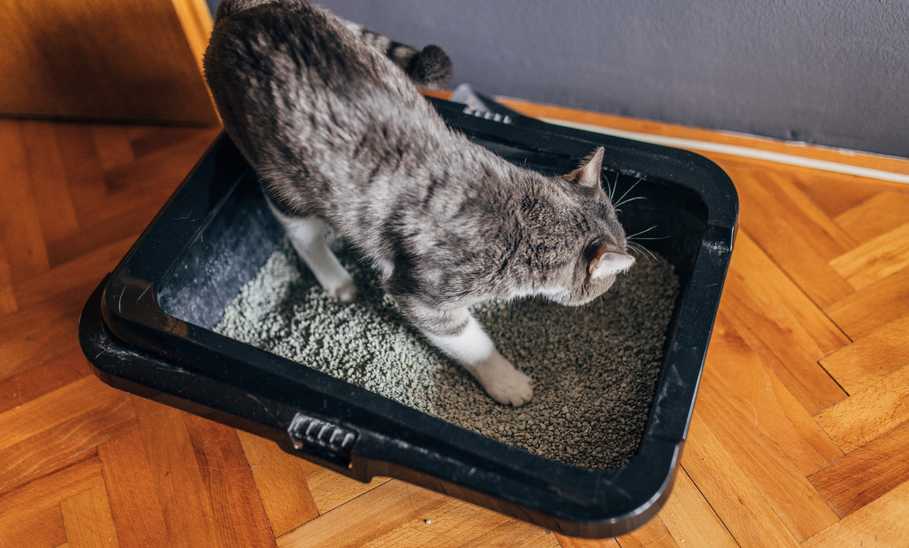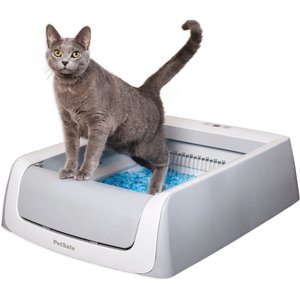Where to Put a Cat Litter Box: The “Business” and Importance of Location

Our evaluations and opinions are not influenced by our advertising relationships, but we may earn a commission from our partners’ links. This content is created by TIME Stamped, under TIME’s direction and produced in accordance with TIME’s editorial guidelines and overseen by TIME’s editorial staff. Learn more about it.
Even though cats are predators, being in the litter box puts them in a vulnerable position. Cats know they’re prey to larger animals and even if there aren’t any larger animals around, the concern is still inherently present. This means litter boxes need to be in locations that help a cat feel safe. Like food and water, a litter box is a valuable resource. For homes with multiple kitties, some cats may be dominant and some may be submissive, so it’s possible for bullying to occur over the litter box—potentially making a submissive cat opt to eliminate elsewhere. Whether you have one or multiple cats, there are key things to consider when deciding where to place a litter box.
A litter box should be placed somewhere quiet, away from lots of traffic and sounds. That means the kitchen isn’t a great area and neither is the laundry room. Your bedroom is a good location as long as the door is always open and late night or early morning litter box activity doesn’t wake you up.
It’s also ideal to put a litter box in a room that’s convenient and familiar for your cat. If your cat normally hangs out in the living room on the first floor, placing the litter box in the guest bedroom on the second floor where you and your cat never hang out, isn’t ideal. The same applies to placing the box in the basement or the garage. These places may also not be as accessible, well lit, or well ventilated.
You’ll also want to try and place the box in a more open area so your cat can feel like they’re able to escape if they’re approached by another pet in the home, or if they’re startled by a sound. Even if your cat lives without other pets, a litter box in a spacious area makes them feel more safe. The area should also be a room where the door is always kept open.
If you have a kitten or a senior cat, keep litter boxes where your cat can easily get to them. The signs of arthritis in senior cats can be subtle and often goes undiagnosed until it’s more advanced. Some cats who are unable to comfortably walk up stairs, or walk further to get to a box, may find somewhere else to urinate, such as on the carpet.
It’s ideal to place litter boxes where it’s well lit during the day and has some light when it’s dark, e.g. with a night light. Though this might seem silly at first since cats have great night vision and wild cats don’t have a nightlight (though there is the moon), visibility adds to a cat’s feeling of safety, which decreases stress. Litter boxes should also be kept in rooms that have good ventilation and that don’t get too hot or humid because these factors enhance odor. Like people, cats don’t like litter boxes that smell bad.
In a smaller living space, a bathroom is a tempting place to put a litter box. If you choose this location, make sure to scoop the box at least once a day to keep down odors since humidity can increase smell. If you have a closet or unused cabinet that can be kept open all the time, that’s an option too but some cats might not like it because it’s not spacious. The feeling of potentially being trapped while being in a vulnerable position can also cause some cats to refuse to use these locations. Ventilation and odors can be problematic as well.
There are also a variety of cat furniture options, but keep in mind that some cats won’t use boxes that are enclosed or covered. This can be for a variety of reasons, like anxiety about being in an enclosed space, increased odor due to decreased ventilation, possibly not enough room to turn around in, and trouble getting in or out, such as for an arthritic cat or a young kitten.
Cats like convenience so it’s best to have a litter box on each floor. This is particularly important if you have senior cats who may have arthritis, even if it’s not obvious that they do. On upper level floors, try to pick rooms that your cat spends time in, like your bedroom or your bathroom instead of a guest room. On the lower level, consider rooms like the living room. Avoid high traffic areas.
The living room, bedroom, and bathroom are all options in a single cat home. Pick areas that are quiet, spacious, well lit, and low-traffic.
The more cats you have, the more creative you have to get. Since the minimum number of litter boxes needed is the number of cats plus one, options include the bedrooms that your cats are used to (e.g. ones they sleep in at night or hang out with a family member during the day), living room, family room, office, and bathrooms. For convenience, you might want to consider getting some self-cleaning litter boxes. If you’re curious about these, read our Litter Robot 4 review.
![[object Object] [object Object]](https://www.litter-robot.com/media/catalog/product/cache/08ae1a83f84b14f24f0ebc5d37342dc8/l/i/litter-robot-image-design-v2.jpg)
Avoid the kitchen because of traffic and for general cleanliness reasons. Also avoid laundry rooms because of unexpected sounds, like the dryer buzzing when done. With multiple cats, it might be tempting to put a box or boxes in a closet or closets, but keep in mind that more submissive cats may not use these locations because close quarters won’t feel safe.
Cats naturally don’t urinate or defecate around the areas where they eat, drink water, or sleep. Though you can have a litter box in the same room where your cat does these things, don’t have the box near bowls or beds.
Avoid high-traffic areas because they tend to have more noise, some of which are unexpected and startling. When cats are in the litter box, they’re already feeling vulnerable to being ambushed, even if there is no actual threat, so being in a quiet location is important.
If there’s already a box in a location, don’t put a second one right next to it. That’s basically one big box as far as cats are concerned. If you do need to use the same room, place the second box as far away as possible from the first.
Cats like to use the litter box in rooms that are familiar and comfortable for them, like a bedroom where they sleep at night or a room they hang out in during the day. So skip the guest bedroom, guest bathroom, or some other obscure location.
Avoid areas like the basement, the garage, or other spaces that don’t have good lighting and good air flow. Cats feel safer in familiar spaces where they can have a good view of what’s going on and where they feel they can escape if needed — even if you know there won’t be any actual threats.
For one cat, it’s ideal to have two litter boxes in separate rooms that your cat is familiar and comfortable with. Cats sometimes like to urinate in one box and defecate in another.
However, if you have a senior cat and a multi-floor home, have a litter box on each floor. Many senior cats are arthritic and often aren’t diagnosed because of how subtle the signs are. For these kitties, try to make getting to a box as convenient as possible.
For two cats, it’s ideal to have at least three boxes. Place them in separate locations that are ideally quiet and not in cramped quarters.
Three cats will need four boxes. Again, if you have cats with special needs or you have senior cats plus a multi-level home, it’s possible you might need to have even more than four boxes for accessibility.

If a medical reason — like a urinary tract infection, diabetes, or hyperthyroidism — has been ruled out and your cat is urinating or defecating outside of their litter box, this can be due to a variety of reasons that have to do with behavior, environment, or both. Also, this is an important conversation to have with your veterinarian.
Litter boxes placed in high traffic areas and areas with loud and/or unexpected startling sounds can be undesirable to cats. Cats prefer their litter boxes in spacious, quiet places. They also like boxes that are convenient to access, so in a room that is close to where they hang out during the day is one ideal place. But don’t put boxes near food, water, or sleep areas. Just like you wouldn’t want your food stored in the bathroom, cats don’t like it either. Areas that are well lit and that have good ventilation — so smells aren’t enhanced — are also best.
Cats have a sensitive sense of smell and may not like scented litter. They also prefer litter that is fine-grain like sand. Unscented clumping litter is great because it has that texture and it’s easy to scoop, but you may have to experiment with different litters to see what your cat prefers. It’s also important to have enough litter in the box. Fill the box so there’s at least two inches of litter. Don’t forget to intermittently add more litter after the level drops from scooping.
No one likes a dirty bathroom and cats are no exception. Think about this: Cats have to step into their litter box — their toilet — and have their face close to the sights and smells. To reduce the chances of your cat not using their litter box due to cleanliness, scoop it at least once a day (more if you can, especially if you have multiple cats). Another option is getting a self-cleaning litter box, although some cats might get spooked by the sounds, at least initially.
It’s also ideal to totally dump out all the litter and wash the box with soap and hot water once to twice a week. Plastic is porous and retains smells but be careful about using bleach. Bleach mixed with the ammonia in cat urine creates a noxious gas. On top of that, bleach can leave a lingering smell and though you may not notice it, your cat who is up close and personal with their box, will. If you don’t like the thought of washing the box because you don’t have a utility sink or a yard, consider using litter box liners. You can read more on how often to clean a litter box here. If your litter boxes are old and permanently gross, buy new ones. Your cat will appreciate it.
Cats like a box big enough for them to comfortably turn around in. Due to things like their sense of smell and their preference for spaciousness, some cats may not like covered or enclosed litter boxes, so you might have to go through some trial and error when selecting boxes. To learn about different types of litter boxes, read our guide on the best litter boxes for cats.
Due to arthritis, some senior cats may experience pain trying to lift their hind legs over the side of a standard style, open-top litter box so make sure the sides are low enough that it’s easy for them to get in. Litter boxes that require jumping to get in aren’t a good idea. Depending on age, kittens can also have trouble getting in — and particularly getting out of — top-entry litter boxes. And if you’re a new kitten owner, congratulations! To optimize your kitten’s success, read more about how to train a kitten to use a litter box.
Self-cleaning litter boxes can be problematic for cats who don’t like enclosed spaces or dark spaces, and who are spooked by the sounds of the box. Cats may also not like how it smells inside an enclosed box. Depending on the size of your cat, the amount of room inside also needs to be considered.
Since the litter box is a key resource just like food and water, it can be a source of stress in multi-cat homes. If you have a cat who is more dominant or territorial over resources, they may not want to share “their” litter boxes and they might intimidate housemates who are more passive. In these situations, it’s helpful to have litter boxes in spacious areas where a more submissive cat can feel like they can see their bully coming and have ways to escape. However, the intimidation doesn’t always happen at the litter box but it can, with the aggressor trying to oust the other cat or pouncing when the cat is leaving. Fights over resources can also break out at other times.
If your submissive cat spends more time in a particular area, put a litter box there as long as it’s not near food, water, and their bed. Using feline pheromone sprays and adding more areas where cats can eat and rest can help reduce overall stress among the dominant cat and submissive cats.
If your cat doesn’t like where a litter box is located, if they can’t comfortably get in and out, or if it doesn’t suit their personal preferences, they may not use it. For the overall well being of your cat, place litter boxes in well lit, low-traffic areas that your cat normally spends time but keep boxes away from their food, water, and beds. It’s best to have one more litter box than the number of cats, though in some situations you might need more, such as with arthritic cats who have mobility issues.
The information presented here is created by TIME Stamped and overseen by TIME editorial staff. To learn more, see our About Us page.



